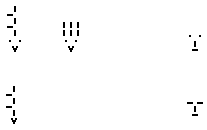y - double point, nearly as broad as the broadest signs
r - triple line, an m with middle line
v - left half of m, or an l shifted left
u - left half of a, or an e shifted left
Pronunciation: y like u in french "du". You can find many examples of words in the dictionary, which is based on this picture-writing with 16 letters. The letter y is not used there until now, but is necessary for many ideograms of animals:

It's impossible to recognize the weasel-like animal sylululi (top left) without eyes (bottom left) as an animal. The same is true of the hedgehog syriri (middle). Also replacing the double point by an other sign, like possible with the human face ely (top right), would destroy the face of these ideograms for animals.
The systematics of the picture writing with 12 letters mostly has been preserved: Consonant signs are high, those for humming consonants consist vertical lines. Vowel signs are flat. But the y-sign has additional spaces below and above it, to make the double point better visible between other signs. With these spaces, the double point is as high as a consonant sign.
The sounds of the vowel signs now are disordered: The rule "The deeper a vowel, the broader its sign" now is not more true for all vowels. But it's possible to order the vowels systematically, for example like this:

